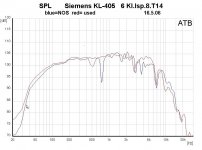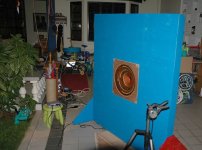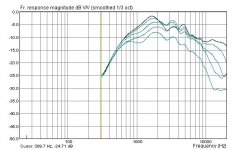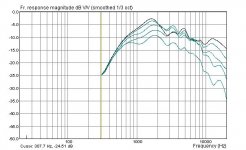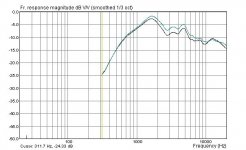el`Ol said:Here is a frequency response graph of a Klangfilm KL.L405 14" driver. Comments?
gimme a pair for proper disposal ..........

Member
Joined 2003
Here is a frequency response graph of a Klangfilm KL.L405 14" driver. Comments?
Based on only the response curve, it seems exceptionally easy to work with. (What causes the 750Hz notch in the one sample?)
Member
Joined 2003
Midrange update...
The 18 Sound 10NDA520 is a true state-of-the-art midbass…high sensitivity, high output, low distortion, etc, etc. My only issue is that frontal radiation is not as directional as I now wanted for this design (the original objective was directional control to around 1.1kHz, but plans changed…so now, no 10” would be directional enough).
Using figure-8 dipole radiation for pattern control produces an unwanted “hot” lobe to the rear…and I am not comfortable using 12-15” drivers up around 1k. So, several weeks ago, I began experimenting with a quad array of RS-180s with the objective of increasing frontal directivity below 1kHz while maintaining the excellent midrange CSD performance of relatively small drivers. Though unusual, this configuration worked really well. Radiation toward side walls was significantly reduced without resorting to a dipole pattern.
I now believe room reflections in the area below 1k are even more important than I first thought because this region is, subjectively, “loud”...walking to the side of these speakers is really quite dramatic. The bottom line for directivity carried lower in frequency is greater clarity and articulation…more low-level program details surface in a "quieter" room. Since the RS-180s were actually purchased for another system, and I already owned 8 of the 18W8531G, the Revelators became the new midrange...the perfect size and great performance. Woofer is the same BMS Pro 18N850 I've been using for about a year.
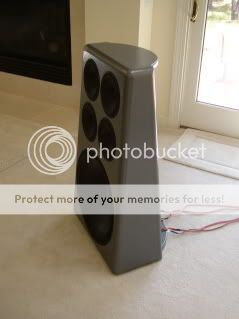
The woofer and mids are mounted on a minimum size cross-braced baffle with 1.25" roundovers. The baffle is tilted 5 degrees to put the midrange on listener axis and shift the CG rearward. Rear radiation fires into a half-cylinder acoustic blanket of half-inch thick F-7 wool felt mounted 'round the backside.

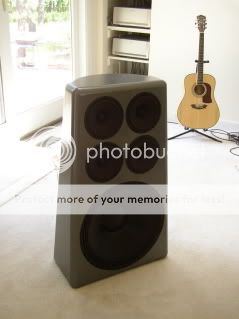
For now, tweeters are the BMS 4552 mounted on 12” MSC waveguides. When more time is available, the plan is to build stand-alone 28” OD waveguides with 16” devoted to directional control, the remainder used for diffraction reduction (roundovers). After I learn the low frequency limit of the 4552, the waveguides will be reworked for BMS 4590’s.
At least that’s the plan for now. 😉
PS: For anyone wanting a lower cost version, an RS-390 and 4 of the RS-150's should work extremely well with a 1" compression driver and 11-12" WG. Another alternative would be two RS-390s (in a ripole configuration) with 4 RS-180's.
The 18 Sound 10NDA520 is a true state-of-the-art midbass…high sensitivity, high output, low distortion, etc, etc. My only issue is that frontal radiation is not as directional as I now wanted for this design (the original objective was directional control to around 1.1kHz, but plans changed…so now, no 10” would be directional enough).
Using figure-8 dipole radiation for pattern control produces an unwanted “hot” lobe to the rear…and I am not comfortable using 12-15” drivers up around 1k. So, several weeks ago, I began experimenting with a quad array of RS-180s with the objective of increasing frontal directivity below 1kHz while maintaining the excellent midrange CSD performance of relatively small drivers. Though unusual, this configuration worked really well. Radiation toward side walls was significantly reduced without resorting to a dipole pattern.
I now believe room reflections in the area below 1k are even more important than I first thought because this region is, subjectively, “loud”...walking to the side of these speakers is really quite dramatic. The bottom line for directivity carried lower in frequency is greater clarity and articulation…more low-level program details surface in a "quieter" room. Since the RS-180s were actually purchased for another system, and I already owned 8 of the 18W8531G, the Revelators became the new midrange...the perfect size and great performance. Woofer is the same BMS Pro 18N850 I've been using for about a year.

The woofer and mids are mounted on a minimum size cross-braced baffle with 1.25" roundovers. The baffle is tilted 5 degrees to put the midrange on listener axis and shift the CG rearward. Rear radiation fires into a half-cylinder acoustic blanket of half-inch thick F-7 wool felt mounted 'round the backside.


For now, tweeters are the BMS 4552 mounted on 12” MSC waveguides. When more time is available, the plan is to build stand-alone 28” OD waveguides with 16” devoted to directional control, the remainder used for diffraction reduction (roundovers). After I learn the low frequency limit of the 4552, the waveguides will be reworked for BMS 4590’s.
At least that’s the plan for now. 😉
PS: For anyone wanting a lower cost version, an RS-390 and 4 of the RS-150's should work extremely well with a 1" compression driver and 11-12" WG. Another alternative would be two RS-390s (in a ripole configuration) with 4 RS-180's.
Nice Paul!
I've played with such a design before - one problem I've found is that you need to be further away from loudspeaker for the sound to "gel", and unfortunately this is counter productive to reduced room reflections.
I've also found that most of the perceived gain in clarity is not a function of the radiation pattern (at least above the modal region), but rather as a result of using more drivers. I'd be interested to see if you feel similarly.
🙂
I've played with such a design before - one problem I've found is that you need to be further away from loudspeaker for the sound to "gel", and unfortunately this is counter productive to reduced room reflections.
I've also found that most of the perceived gain in clarity is not a function of the radiation pattern (at least above the modal region), but rather as a result of using more drivers. I'd be interested to see if you feel similarly.
🙂
Member
Joined 2003
Hey Scott,
How far from the speakers were you? With the current room layout, my listening distance is fixed at 11-12 feet. When I've had "gel" problems, "you-know-who" has made a mistake in the crossover network . I now carefully EQ driver response beyond crossover, apply appropriate delays, etc. In this case, the Scans make that easy because they are so well behaved...BMS, not so well behaved as the Scans, but good enough.
. I now carefully EQ driver response beyond crossover, apply appropriate delays, etc. In this case, the Scans make that easy because they are so well behaved...BMS, not so well behaved as the Scans, but good enough.
Improved clarity as a function of more drivers...well, I agree at high listening levels. Yesterday, I listened to a few cuts at extremely high levels...louder than the new TAD and KEFs I heard played to their limits in NYC last month. Had there been only one midrange per channel, I'm reasonably certain I'd have heard the onset of audible distortion, or reduced clarity. On the other hand, improved clarity purely as a function of more drivers/lower excursion must have limitations down in the 80-90 db range. There has to be more going on...I chalk it up to radiation pattern.
Paul
How far from the speakers were you? With the current room layout, my listening distance is fixed at 11-12 feet. When I've had "gel" problems, "you-know-who" has made a mistake in the crossover network
 . I now carefully EQ driver response beyond crossover, apply appropriate delays, etc. In this case, the Scans make that easy because they are so well behaved...BMS, not so well behaved as the Scans, but good enough.
. I now carefully EQ driver response beyond crossover, apply appropriate delays, etc. In this case, the Scans make that easy because they are so well behaved...BMS, not so well behaved as the Scans, but good enough.Improved clarity as a function of more drivers...well, I agree at high listening levels. Yesterday, I listened to a few cuts at extremely high levels...louder than the new TAD and KEFs I heard played to their limits in NYC last month. Had there been only one midrange per channel, I'm reasonably certain I'd have heard the onset of audible distortion, or reduced clarity. On the other hand, improved clarity purely as a function of more drivers/lower excursion must have limitations down in the 80-90 db range. There has to be more going on...I chalk it up to radiation pattern.
Paul
Paul W said:Hey Scott,
How far from the speakers were you? With the current room layout, my listening distance is fixed at 11-12 feet. When I've had "gel" problems, "you-know-who" has made a mistake in the crossover network. I now carefully EQ driver response beyond crossover, apply appropriate delays, etc. In this case, the Scans make that easy because they are so well behaved...BMS, not so well behaved as the Scans, but good enough.
Improved clarity as a function of more drivers...well, I agree at high listening levels. Yesterday, I listened to a few cuts at extremely high levels...louder than the new TAD and KEFs I heard played to their limits in NYC last month. Had there been only one midrange per channel, I'm reasonably certain I'd have heard the onset of audible distortion, or reduced clarity. On the other hand, improved clarity purely as a function of more drivers/lower excursion must have limitations down in the 80-90 db range. There has to be more going on...I chalk it up to radiation pattern.
Paul
About 8-9 feet for me.. but perhaps I'm more sensitive to this? You could be correct though, my lowpass might not have been steep enough or low enough in freq. (don't remember.)
I don't think there is more going on (well, broadly speaking). There may well be some advantages with baffle interaction however (depending on the drivers, baffle size, and driver placement).
If you have the time (and inclination) - try it out, I think you will be surprised - I was (..i.e. I preferred the narrow baffle and vertical array configuration).
🙂
Member
Joined 2003
Do you mean a narrow-baffle vertical configuration like this?
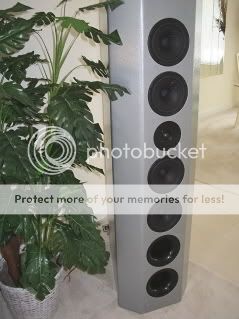
The first time I used these drivers was about 4 years ago in a 2.5 way 🙂 ...different objectives at that time.

The first time I used these drivers was about 4 years ago in a 2.5 way 🙂 ...different objectives at that time.
Paul W said:Do you mean a narrow-baffle vertical configuration like this?

The first time I used these drivers was about 4 years ago in a 2.5 way 🙂 ...different objectives at that time.
yes and no..
open baffle (virtually no baffle, similar in width though of course not enclosed). Definitely not an MTM though (i.e. no driver separation).
My DIY loudspeaker "saga":
First I started out with the original Alon/Dahlquist design (open baffle mid, a good starting point for a Hi Fi design). Next I did the basic design you have, (Legacy Audio inspired, but dipole and basically an extension of the Alon design), though without the dipole midbass driver - didn't like it and then tried out a short 4 driver vertical line on a "whim". MUCH better.. Then onto a line array (..everything big all the time and not much physical impact). Then high eff. drivers (with a short horn "stint"). Then High Eff. fullrange drivers. Then dipoles below the modal region (..thank you SL, drums are finally correctly "placed"). Then High Eff. dipoles below the modal region (SL's missing out). Then radial drivers (well before SL.. and he is missing out here with such a simplistic design as the Pluto). Now a hybrid of radials with dipole midbass. The one common feature though was always using "cheap" drivers - what can I say, for me its a poor man's odyssey (largely because it started while still in college).
 I've never had the cojones to do something as awe inspiring as your DIY ribbon.
I've never had the cojones to do something as awe inspiring as your DIY ribbon.Paul,
wow, you work at the speed of light... not to mention the unusual design, and good drivers as well! Not exactly cheap though!
So the quad works out well... I am also amazed at the build quality of the cabinet, this looks all perfectly finished, in a matter of what, 2 weeks? But say, (I mentioned this before), wasn't a "smaller form factor" an initial design goal? 😀
Me I was away a few days and then had a rough week, so in the past couple days I just barely managed to finish my 5x5' test baffle so I can *finally* test the 15" horn, and hopefully get satisfying CSD's as well for all dricers, because the driver to baffle edge distance should now be good enough. I don't know yet if the test baffle is well damped enough, I did use a lot of bracing but I used a lot of leftover scrap materials which I ended up caulking shut with liquid rubber.
Once I got data we should know more about a 15" WG (with full roundover it would be 21", not quite the 28" you are planning) But my gut feeling is that the roundover is not so important in a WG used in its directional range: if it does its job, it *is* directional and not much sound should hit the roundover anyway.
wow, you work at the speed of light... not to mention the unusual design, and good drivers as well! Not exactly cheap though!
So the quad works out well... I am also amazed at the build quality of the cabinet, this looks all perfectly finished, in a matter of what, 2 weeks? But say, (I mentioned this before), wasn't a "smaller form factor" an initial design goal? 😀
Me I was away a few days and then had a rough week, so in the past couple days I just barely managed to finish my 5x5' test baffle so I can *finally* test the 15" horn, and hopefully get satisfying CSD's as well for all dricers, because the driver to baffle edge distance should now be good enough. I don't know yet if the test baffle is well damped enough, I did use a lot of bracing but I used a lot of leftover scrap materials which I ended up caulking shut with liquid rubber.
Once I got data we should know more about a 15" WG (with full roundover it would be 21", not quite the 28" you are planning) But my gut feeling is that the roundover is not so important in a WG used in its directional range: if it does its job, it *is* directional and not much sound should hit the roundover anyway.
Paul W, I'm sorry if this is a little off topic for this thread, but what are your impressions of that BMSPro 18N850? ...and is it the V2? The motor design on that thing looks pretty SOA, as good as or better than 18Sound's tech.
BTW, love the cabinet work on that quad driver + 18 cabinet, very nice!
BTW, love the cabinet work on that quad driver + 18 cabinet, very nice!
Member
Joined 2003
Scott,
Got any photos you can share? You're clearly not afraid to go off the beaten path and I'd really like to see what you're doing with the radials. In light of your comments a few months ago, I listened to the big MBL's again in NYC...without the huge crowd in a small room as at the LA show. I can see how you like the radial spatial presentation in 2-channel. The problem this year was the guy on the volume control...they were playing so loud they were beginning to distort and took on a hard metallic edge. Still, many of the other expensive speakers there were pure junk by comparison. "Best of show" for me were Andrew Jones new TADs and the big KEFs shown in the next room. But I digress...pictures?
MBK,
Heck, these are smaller in every dimension! Even with the WG, the only measurement near the old ones will be WG width which will equal the old. But, truthfully, you're right...they are larger than I wanted. Sometimes physics gets in the way of good sound!
Really curious to see your WG results. Though diffraction doesn't show up in my near-WG measurements, it appears to be present in-room at listening distance. But, with all the reflections in-room, I'm not certain what I'm seeing is edge diffraction...plus the WG baffle only has a half-inch roundover, so nothing conclusive. I really should take the WGs outside for some distance measurements (where all points on the baffle are relatively equal distance to the mic) but now I'm running short of time...maybe because I spent too much time on new baffles 🙂
Paul
Got any photos you can share? You're clearly not afraid to go off the beaten path and I'd really like to see what you're doing with the radials. In light of your comments a few months ago, I listened to the big MBL's again in NYC...without the huge crowd in a small room as at the LA show. I can see how you like the radial spatial presentation in 2-channel. The problem this year was the guy on the volume control...they were playing so loud they were beginning to distort and took on a hard metallic edge. Still, many of the other expensive speakers there were pure junk by comparison. "Best of show" for me were Andrew Jones new TADs and the big KEFs shown in the next room. But I digress...pictures?
MBK,
Heck, these are smaller in every dimension! Even with the WG, the only measurement near the old ones will be WG width which will equal the old. But, truthfully, you're right...they are larger than I wanted. Sometimes physics gets in the way of good sound!
Really curious to see your WG results. Though diffraction doesn't show up in my near-WG measurements, it appears to be present in-room at listening distance. But, with all the reflections in-room, I'm not certain what I'm seeing is edge diffraction...plus the WG baffle only has a half-inch roundover, so nothing conclusive. I really should take the WGs outside for some distance measurements (where all points on the baffle are relatively equal distance to the mic) but now I'm running short of time...maybe because I spent too much time on new baffles 🙂
Paul
Member
Joined 2003
Thanks John. I'm very satisfied with the BMS 18. (I've had them for over a year so they are V1.) The drivers are very "boring" in the sense that they work almost exactly as advertised. Response is a little smoother than the factory graphs...probably different measurement environment. There is also a small breakup at about 10k which I think is the dustcap. Very low distortion. Extremely stiff, heavy, cone with scary powerful motor requires attention to prevent baffle shake. Very low Qts requires substantial EQ in a small baffle.
I looked at 18 Sound when I bought the BMS but, even a year later, I think they are at least the equal of 18S.
I looked at 18 Sound when I bought the BMS but, even a year later, I think they are at least the equal of 18S.
Hi Paul,
well, true, your ribbon lines were larger still... but with museum of modern art quality looks...
What I forgot to ask:
- with the reduced lateral dispersion of the quad, how is the impression of sound spaciousness in-room?
- since you have heavy (pun intended) experience with wool felt: have you ever measured the effect of the felt on backwave FR and especially, on lateral dispersion? Basically, do the so treated OB's really develop a cardioid pattern, or does the felt remove the rear output so much that dispersion resembles a monopole more?
- your WG comments indicate you want to push X-O to sub-800 Hz levels now. Right?
Actually I hope the 15" WG will allow 800 Hz, will see when the paint on the test baffle is dry... I really hope it doesn't rattle. I'll do it outdoors but with that baffle size I should be able to easily afford windowing for tweeter freqencies, to get rid of baffle edge and floor effects.
well, true, your ribbon lines were larger still... but with museum of modern art quality looks...
What I forgot to ask:
- with the reduced lateral dispersion of the quad, how is the impression of sound spaciousness in-room?
- since you have heavy (pun intended) experience with wool felt: have you ever measured the effect of the felt on backwave FR and especially, on lateral dispersion? Basically, do the so treated OB's really develop a cardioid pattern, or does the felt remove the rear output so much that dispersion resembles a monopole more?
- your WG comments indicate you want to push X-O to sub-800 Hz levels now. Right?
Actually I hope the 15" WG will allow 800 Hz, will see when the paint on the test baffle is dry... I really hope it doesn't rattle. I'll do it outdoors but with that baffle size I should be able to easily afford windowing for tweeter freqencies, to get rid of baffle edge and floor effects.
Member
Joined 2003
The ribbon cabinets even received compliments from females...a high honor, especially considering the size. Last week, overrun with speakers, I took a chain saw to ten cabinets and baffles, including the vertical MMTMM pictured above. The ribbon cabinets escaped the "chain saw massacre" by hiding in the garage.well, true, your ribbon lines were larger still... but with museum of modern art quality looks...
Most of my serious listening now is SACD and DVD-A. Since I believe multi-channel is the future (regardless of format wars) I'm aiming my system more and more in that direction (pun intended) where more spacial clues come from the program material in other channels. That said, the quad mid is significantly directional...very similar to a large ESL or planar. They throw very strong images across the stage (between the speakers) but very little to the sides. The ability to add, delete, or change felt density provides significant flexibility in the presentation...for example, light felt can place some musicians to the outside and behind the speakers.with the reduced lateral dispersion of the quad, how is the impression of sound spaciousness in-room?
I have not measured with proper rigor. By the time of felt installation (basically the last step before crossover) I'm very anxious to listen! However, based on my experience so far, it is possible to get a very broad range of backwave output by changing felt thickness, density, etc. The half-inch felt I'm using now was selected for a little greater HF attenuation than past speakers. I do promise to get some decent outdoor polar measurements at some point.- since you have heavy (pun intended) experience with wool felt: have you ever measured the effect of the felt on backwave FR and especially, on lateral dispersion? Basically, do the so treated OB's really develop a cardioid pattern, or does the felt remove the rear output so much that dispersion resembles a monopole more?
Correct. sub-800 Hz is below the subtle Scan Speak "bobble" around 800-900 Hz...so the Revelators will be operating inside their "ideal" range. (I understand the SS bobble is a reflection from the cone edge/surround junction.)- your WG comments indicate you want to push X-O to sub-800 Hz levels now. Right?
The new 5x5' test baffle you've built should be more than good enough for WG FR testing. If you get reflections, you can always move the mic a little closer. Paint should be dry by the time you read this 😎
Paul W said:Scott,
Got any photos you can share? You're clearly not afraid to go off the beaten path and I'd really like to see what you're doing with the radials. In light of your comments a few months ago, I listened to the big MBL's again in NYC...without the huge crowd in a small room as at the LA show. I can see how you like the radial spatial presentation in 2-channel. The problem this year was the guy on the volume control...they were playing so loud they were beginning to distort and took on a hard metallic edge. Still, many of the other expensive speakers there were pure junk by comparison. "Best of show" for me were Andrew Jones new TADs and the big KEFs shown in the next room. But I digress...pictures?
Not a one, and most projects no longer exist beyond boxed-up drivers (and even then many drivers were given away).
The driver I am playing with for a radial (at this time) is an in-expensive Altec fullrange driver (..its surprisingly well built). I was considering a commercial design based on this, but unfortunately its still to low in eff. (..in a radial I'd estimate its about 7.5 db down from its referenced 93-4 db). The nice thing about it is its a low mass design, (very detailed), AND its off axis (-80 degrees) is superb up to about 1.8 kHz.
My current problem in the progression of this design though is measuring. I don't have that capability, and won't again for several months (I'm also waiting on Sound Easy 14). Still, padding down the Neo 8 and adding a simple cap (near that 1.8 kHz) suggests something stunning. (I still need to get the G2si's for the top end). (..the dual 16 ohm 10" knights are used for a dipole midbass, and frankly they are too high in level.. need to get another inductor). Of course it looks like an assemblage of cr@p 😀 , but I'm not in any particular hurry and have more than a little from other "areas" to keep me occupied. (..still trying to sort through the info. from the prof. conference I attended last week ..the sad thing is, that conference cost me more than my entire expenditure on loudspeaker construction
 , well - not including my time. 😉 )
, well - not including my time. 😉 )OK, so I did a first batch of measurements with the Vifa 27TG35-06, on flat baffle and horn, and when on the horn then with and without its OEM faceplate, and all this from 0 to 60 degrees off axis.
Test baffle ca. 5x5 ft, outdoors, windowed at the first reflection which was ca. 3 ms (floor, presumably).
Note that the outdoors was not a good idea - there is traffic, AC hum from the neighbors, and I spent ages to conclude what a strange wiggle in the 5k region might be. I thought windowing artefacts, or reflections from my primitive mic mounting "method" with a clamp (which never mattered before). In all likelihood it actually was some cicadas which didn't stop chirping for hours 🙄 ... next time tweeter tests shall be conducted indoors.
Test environment in pic.
Test baffle ca. 5x5 ft, outdoors, windowed at the first reflection which was ca. 3 ms (floor, presumably).
Note that the outdoors was not a good idea - there is traffic, AC hum from the neighbors, and I spent ages to conclude what a strange wiggle in the 5k region might be. I thought windowing artefacts, or reflections from my primitive mic mounting "method" with a clamp (which never mattered before). In all likelihood it actually was some cicadas which didn't stop chirping for hours 🙄 ... next time tweeter tests shall be conducted indoors.
Test environment in pic.
Attachments
As above, but tweeter mounted without faceplate (just pressed against baffle backside. I see no substantial difference, the response inversion 2-5k is still there (brown curve, as above, is 0 degrees, then down to 60 degrees in 15 degree steps)
Attachments
- Status
- Not open for further replies.
- Home
- Loudspeakers
- Multi-Way
- Large midrange for OB??? Scott G ?
